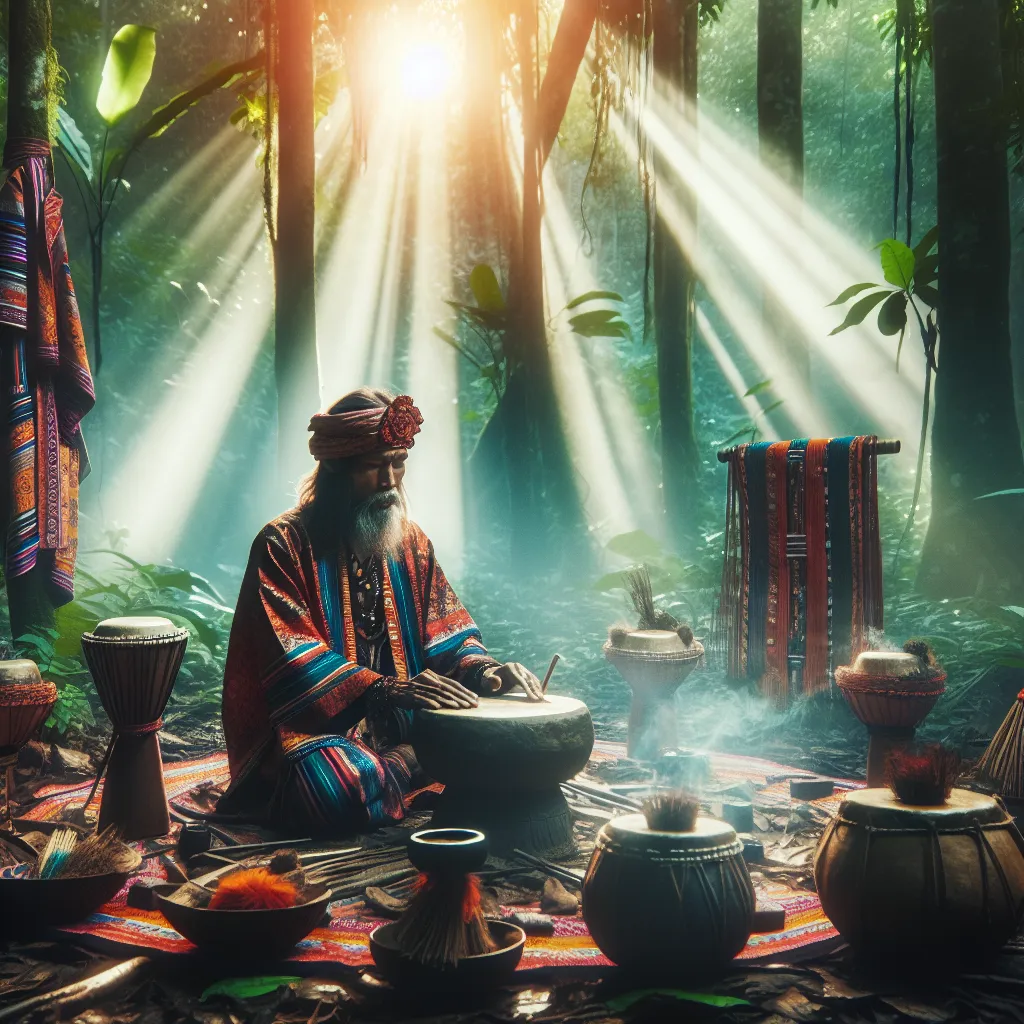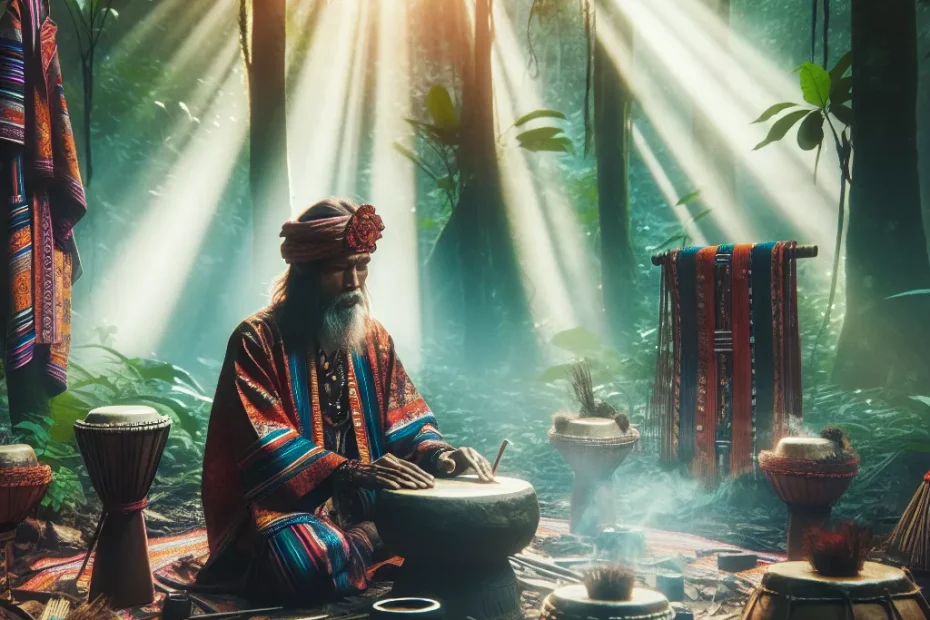Shamanism has long been an integral part of Korean culture, with a rich history and deep-rooted traditions. Originating from ancient times, Korean Shamanism has evolved over the centuries, shaping the beliefs and practices of the Korean people. Shamans play a crucial role in society, acting as intermediaries between the spiritual and physical worlds. Despite its historical significance, Korean Shamanism continues to influence modern Korean society, sparking debates and controversies. Understanding the origins, beliefs, and societal roles of Korean Shamanism provides valuable insights into the cultural fabric of Korea.

Origins and History of Shamanism in Korea
Shamanism in Korea dates back thousands of years, deeply rooted in the country’s history and culture. The origins of Korean shamanism can be traced to the ancient belief systems of the Korean people, blending elements of animism, indigenous religious practices, and folk beliefs. Shamans, known as “mudang” in Korean, play a vital role in connecting the spiritual world with the physical realm, acting as intermediaries between humans and the divine.
The Rich History of Korean Shamanism
The history of Korean shamanism is rich and complex, with different regional variations and practices evolving over time. Shamanic rituals and ceremonies are performed for various purposes, including healing, exorcism, fortune-telling, and offering guidance to individuals and communities. These rituals often involve music, dance, chants, and elaborate costumes, creating a mesmerizing and mystical atmosphere.
Influences and Evolution
Scholars believe that Korean shamanism has been influenced by neighboring cultures, such as Chinese Taoism and Buddhism, which were introduced to Korea in ancient times. However, shamanism in Korea has maintained its distinct identity and continues to be an integral part of Korean cultural heritage.
Resilience and Adaptation
Throughout history, shamanism in Korea has faced periods of suppression and revival, particularly during times of political and social change. Despite attempts to marginalize shamanic practices, shamanism has persisted and adapted, demonstrating its resilience and enduring significance in Korean society.
Modern Shamanism in Korea
Today, shamanism in Korea remains a vibrant and dynamic tradition, with modern shamans incorporating new elements and technologies into their practices. While the role of shamans in Korean society has evolved, their spiritual guidance and healing abilities continue to be sought after by many people seeking solace and answers in a rapidly changing world.
Continued Relevance
In conclusion, the origins and history of shamanism in Korea reflect a deep connection to the spiritual world and a profound respect for the natural order of the universe. As a cornerstone of Korean culture, shamanism continues to thrive and evolve, bridging the gap between the seen and unseen realms, offering comfort and wisdom to those in need.
Key Beliefs and Practices in Korean Shamanism
Korean Shamanism, also known as Muism or Sinism, is a traditional indigenous belief system that has been an integral part of Korean culture for centuries. Shamanism in Korea encompasses a wide range of beliefs, rituals, and practices that are deeply rooted in the spiritual heritage of the Korean people. Let’s delve into some key beliefs and practices that define Korean Shamanism!
Belief in the Spirit World
Central to Korean Shamanism is the belief in the spirit world, where spirits of ancestors, gods, and other supernatural beings reside. Shamans, known as mudang, act as intermediaries between the human world and the spirit world, communicating with spirits to seek guidance, healing, and protection.
Nature Worship
Korean Shamans hold a deep reverence for nature, believing that all natural elements possess spirits. Mountains, rivers, trees, and rocks are considered sacred, and rituals are performed to honor and communicate with these nature spirits. This connection to nature is a fundamental aspect of Korean Shamanism.
Ancestor Veneration
Ancestor worship is a significant practice in Korean Shamanism. Ancestors are believed to play a vital role in the lives of their descendants, offering protection, blessings, and guidance. Rituals honoring ancestors, such as Charye (ancestor memorial rites), are performed to show respect and gratitude to the ancestral spirits.
Music and Dance
Music and dance are essential components of Korean Shamanistic rituals. Shamans perform intricate dances accompanied by rhythmic drumming and chanting to enter a trance-like state and connect with the spirit world. These rituals are not only spiritual but also serve as a form of artistic expression and cultural preservation.
Shamanic Healing
Korean Shamans are revered for their healing abilities. Through rituals, chants, and herbal remedies, shamans help individuals overcome physical, emotional, and spiritual ailments. Shamanic healing practices aim to restore harmony and balance within the individual and the community.
Ritual Offerings
Offerings play a crucial role in Korean Shamanistic practices. Food, drink, incense, and other symbolic items are presented to the spirits during rituals as a sign of respect and gratitude. These offerings are believed to appease the spirits and ensure their blessings and protection.
Divination
Divination is a common practice in Korean Shamanism to seek answers to questions, predict the future, or gain insight into current situations. Shamans use various methods such as the tossing of wooden sticks (bokjumeoni) or reading patterns in rice grains to interpret messages from the spirits.
In conclusion, Korean Shamanism is a rich and diverse belief system that reflects the deep spiritual connection of the Korean people to the natural and supernatural worlds. The key beliefs and practices outlined above offer a glimpse into the fascinating world of Korean Shamanism and its enduring influence on Korean culture and society.
Roles and Responsibilities of Shamans in Korean Society
In Korean society, shamans play a vital role in connecting the spiritual world with the physical realm. They are revered for their ability to communicate with ancestors, spirits, and gods to provide guidance, healing, and protection to individuals and communities. Shamans, known as “mudang” in Korean, undergo rigorous training and initiation processes to acquire the necessary skills and knowledge to fulfill their sacred duties.
Primary Responsibilities of Shamans
One of the primary responsibilities of shamans is to conduct rituals and ceremonies to honor ancestors and appease spirits. These rituals often involve intricate dances, chants, and offerings to establish harmony between the human world and the spiritual realm. Through these ceremonies, shamans seek to maintain balance and ensure the well-being of the community.
Did you know that shamans also serve as mediators between the living and the dead? They perform rituals to guide the souls of the deceased to the afterlife and help resolve any lingering issues or unfinished business that may be affecting the spirits. This role highlights the deep respect and reverence that Koreans hold for their ancestors and the importance of maintaining a harmonious relationship with the spirit world.
Spiritual Guidance and Healing
In times of crisis or illness, individuals often turn to shamans for spiritual guidance and healing. Shamans use various divination techniques, such as reading signs in nature or interpreting dreams, to diagnose the root cause of problems and offer solutions. By channeling divine energy and invoking the aid of benevolent spirits, shamans facilitate the healing process and bring comfort to those in need.
Furthermore, shamans are regarded as protectors of their communities, using their spiritual powers to ward off evil forces and negative energies. They perform rituals to cleanse spaces of malevolent influences and offer blessings for prosperity and good fortune. The presence of a shaman in a village or town is believed to bring peace, prosperity, and spiritual protection to the residents.
Cultural and Spiritual Heritage
The role of shamans in Korean society is deeply intertwined with the cultural and spiritual heritage of the country. They serve as guardians of tradition, preserving ancient rituals and practices that have been passed down through generations. By bridging the gap between the human and spirit worlds, shamans continue to play a crucial role in maintaining the spiritual well-being and harmony of Korean society.
In conclusion, the roles and responsibilities of shamans in Korean society are multifaceted and essential for the spiritual and cultural fabric of the nation. Their dedication to preserving traditions, healing the sick, guiding the departed, and protecting the community underscores the profound impact that shamans have on the lives of individuals and the collective consciousness of the Korean people.
Modern Influence and Controversies Surrounding Korean Shamanism
Korean shamanism, also known as Muism or Sinism, has a rich history deeply intertwined with the cultural and spiritual heritage of Korea. Despite its ancient roots, Korean shamanism continues to exert a significant influence on modern Korean society, shaping beliefs, practices, and even politics. The resurgence of interest in shamanism in recent years has sparked both fascination and controversy, as traditional practices collide with contemporary values.
Contemporary Presence of Shamanism in South Korea
In contemporary South Korea, shamanism remains a vibrant and visible aspect of cultural life. According to recent surveys, approximately 16% of South Koreans identify as followers of shamanism, showcasing the enduring popularity of these traditional beliefs. Shamanic rituals and ceremonies are still performed across the country, with shamans playing a crucial role in important life events such as weddings, funerals, and business openings.
Modern Influence on Korean Culture
The modern influence of Korean shamanism extends beyond religious practices, impacting various aspects of Korean culture. Shamanistic motifs can be seen in Korean art, literature, and even popular culture, reflecting a continued fascination with the spiritual world. Contemporary artists often draw inspiration from shamanic symbols and themes, creating a bridge between the past and the present.
Controversies and Challenges
However, the resurgence of Korean shamanism has also brought about controversies and challenges. Critics argue that shamanism perpetuates outdated superstitions and hinders social progress. The commercialization of shamanistic practices, with some shamans charging exorbitant fees for their services, has raised ethical concerns and sparked debates about authenticity.
Despite these controversies, Korean shamanism continues to thrive and evolve in the modern era. The adaptability of shamanistic beliefs and practices has allowed them to coexist with other religious traditions, creating a unique spiritual landscape in Korea. As the country grapples with rapid modernization and globalization, the role of shamanism in Korean society remains a complex and intriguing subject worthy of further exploration.
In conclusion, the modern influence and controversies surrounding Korean shamanism highlight the enduring relevance of traditional beliefs in contemporary society. As Korea continues to navigate the complexities of cultural heritage and modernity, the role of shamanism serves as a fascinating lens through which to examine the evolving dynamics of faith, identity, and spirituality in the 21st century. 🌟✨🔮
Shamanism in Korean culture has a rich history and profound influence on society. From its ancient origins to its modern controversies, Korean shamanism remains a significant aspect of the country’s cultural identity. The key beliefs and practices of Korean shamans reflect a deep connection to nature and the spiritual world, providing insight into the traditional values of the Korean people. The roles and responsibilities of shamans in Korean society highlight their importance as mediators between the human and spirit realms, offering guidance and healing to those in need. Despite facing challenges and controversies in the modern era, Korean shamanism continues to play a vital role in preserving cultural heritage and spiritual traditions. Its enduring presence serves as a reminder of the enduring power of tradition and the resilience of cultural practices in a rapidly changing world.
